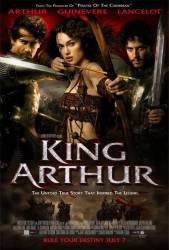Factual error: At the very beginning of the movie, the voice-over tells us it's around 300 AD. We see Roman soldiers, carrying shields and standards with the Chi Rho symbols. Those weren't introduced around 300 AD, but much later. Legend has it that emperor Constantine ordered his men to paint the symbols on their shields before a battle in 312, but Constantine's Arch in Rome, which depicts his victorious soldiers, doesn't show any of these symbols and the symbols in the movie are made of iron, not paint. (00:00:50)
Factual error: The Romans left England in 410 AD and the Anglo-Saxons didn't arrive in England until the late sixth century. Between these times the Britons were in control of the island. (00:23:55)
Factual error: I normally wouldn't bother with this sort of nitpicking, but this film specifically claims to be historically researched - and it's full of historical blunders. For a start, the film is set as the Empire withdraws its last troops from Britain - which was in 407 AD. Now Artorius Castus was a real Roman officer who really did command Sarmatian foederati at Hadrian's Wall, but he died around 200 AD. Cerdic was a real Saxon warlord who did go raiding the Britons with his son Cynric, but he did this in the early 500s. Pelagius really was tried for heresy, but he was acquitted and died of old age; the trial was a decade after this setting, and in the fifth century you couldn't be executed for heresy anyway. Also in the fifth century the Pope had no authority over Imperial troops. I could go on and on but that will do for now.
Factual error: In the beginning, which is around 400 A.D., it shows that the saddles have stirrups on them. Stirrups were not introduced in Europe until centuries after the fall of the Western Roman Empire.
Factual error: Tristan's bird of prey is a Harris' Hawk - a species native to the South-West United States and Mexico, and thus unknown and unavailable in Europe at the time the movie is supposed to take place.
Factual error: All the Roman troops wear armour and uniforms appropriate to the 1st century AD (the "classic" era most often depicted in illustrations). The film is actually set several hundred years later, by which time Roman soldiers looked very different.
Factual error: The major Saxon invasion (the one we see in the movie) was set around 400 A.D. After a short time in the film, the battle of Badon Hill starts. This battle is thought to have occurred around 500 A.D. Arthur must be VERY old.
Factual error: The artillery in this movie are counterweight trebuchets, a type powered by a falling weight. The Romans had many spring and torsion powered artillery, such as scorpions, ballistas and catapults, but did not have trebuchets. By the 3rd century BC the Chinese had the "torsion trebuchet", similar to a trebuchet but powered by men hauling on ropes instead of a falling weight; it didn't reach Europe until the late sixth century. The pure counterweight trebuchet as shown in the movie sometime in the fifth century AD probably didn't exist before the late 12th century and the first one in Britain was built in 1216 AD.
Factual error: The Emperor ruled the Roman Empire, not the Pope. Neither he nor one of his bishops would have any authority over Roman provinces or Roman soldiers.
Factual error: The scene in which the two armies confront each other on the frozen lake contains several flaws. First, when thick ice is broken with a sharp object like a pickaxe, you merely get a hole through the ice, it will only fragment into large pieces if it is thin. Clearly, this is not the case, as the armies are able to walk on it. Second, ice does not shatter in the way depicted in the film, with cracks travelling outwards a great distance, but just crumbles around the area where force is applied. Third, if cracks did radiate outwards, they would propagate sideways and backwards as well as forwards (like glass does when it is punctured by a small, sharp object), meaning that both armies would end up falling through the ice.
Factual error: Two things are wrong about the trebuchets. While Romans did have siege engines, like the catapult and the ballista, the trenches apparently is a Chinese invention. In any case, it wasn't introduced in Europe until the Middle Ages. Also a trebuchet is a complicated device, much more difficult to operate then it looks. Firing it is easy, but hitting a target certainly isn't. (With modern reconstructions, even when using ballistic calculations, it still takes days of practice to get to a point of some accuracy.) When the Roman army left, the trebuchets were completely useless. In the final battle the Woads nevertheless use them to great effect - impossible.






Answer: I don't think it's supposed to be German. Probably Old Saxon. Could be something like "slahten fiand" - slaughter enemy.